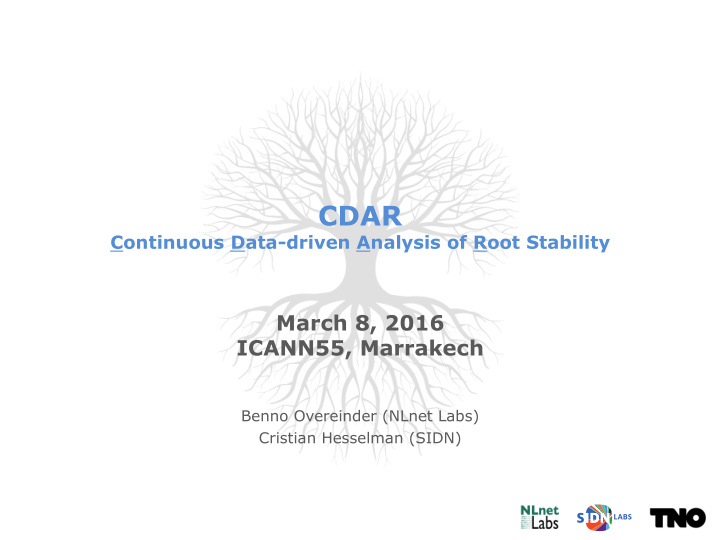



CDAR Continuous Data-driven Analysis of Root Stability March 8, 2016 ICANN55, Marrakech Benno Overeinder (NLnet Labs) Cristian Hesselman (SIDN)
Objective • Analyze technical impact of the New gTLD Program on stability of the root server system • Input for policy development by ICANN community – For instance to develop contingency plans • Today’s goal: share and discuss approach and preliminary results Continuous Data-driven Analysis of Root Stability
Community Interaction Oct Dec Jan Feb Mar Apr Jun Oct 2015 2015 2016 2016 2016 2016 2016 2016 Continuous Data-driven Analysis of Root Stability
Public Comments • Feedback Business Constituency and an individual (DK) Main comments CDAR response Clarify limitations of the study Study results will be a point of reference for RSS stability, comparable to past (DITL) references and extrapolation to near future scenarios where possible, but no stability “guarantees” can be provided CDAR should identify risk CDAR will refine threats to RSS stability into parameters, ICANN should measurable metrics prepare contingency plans Outreach to broad DNS CDAR team presents at many events and is community to validate open to any constructive suggestion (within methodology and review results the defined scope of the study) Specific questions about Results will be distinguished in relevant TLD breakdowns of study results and geographic classes Continuous Data-driven Analysis of Root Stability
Approach • Analysis over time of root stability parameters – Volume and type of new gTLD DNS traffic – Performance (round-trip times) – Correctness (DNS response codes) – Reachability (routes) – DNSSEC validation (valid/bogus delegations) • Using real-world data – Passive: DITL and RSSAC002 – Active: ATLAS/DNSMON, CDAR’s (e.g., DNSSEC validation) • Develop and share tools for continuous analysis • Close interaction with the broader tech community – ICANN, DNS-OARC, IEPG/IETF Continuous Data-driven Analysis of Root Stability
RSSAC002 and DITL Analysis The percentage of queries to New gTLDs has increased from DITL 2014 to DITL 2015, but is still very low compared to other types of queries New gTLD New gTLD queries: queries: 0,20% 0,04% 1000 900 Root Zone size 800 700 600 500 400 300 04/01/14 07/01/14 10/01/14 01/01/15 04/01/15 07/01/15 10/01/15 01/01/16 Continuous Data-driven Analysis of Root Stability Date
Analysis of PCAP Data The volume of root traffic for a new gTLD often decreases significantly after delegation (gTLDs A and B), but sometimes also increases (gTLD C) or increases temporarily (gTLD D) New gTLD A New gTLD B Delegation dates Delegation dates New gTLD D New gTLD C Continuous Data-driven Analysis of Root Stability
RIPE ATLAS Analysis (incl. DNSMON) For one specific data point (Jan 18, 2014), the delega;on of 16 New gTLDs had no sta;s;cally significant impact on the RTT Continuous Data-driven Analysis of Root Stability
Next Steps • Continue outreach and community interaction – After this presentation – DNS-OARC and IEPG meetings in April (Buenos Aires) – ICANN56 • Further data analysis – Break down of DNS traffic per TLD per root letter – Add more data points at which the root zone grew – Analyze stability parameters for different types of TLDs – Develop and share tools for continuous analysis – Use analysis for scenario development • Obtain more measurement data – Work with RSOs to obtain root server PCAPs – Include DITL2016 (April) – Historical DSC data (DNS-OARC) Continuous Data-driven Analysis of Root Stability
Questions and Discussion CDAR Project Team Bart Gijsen (TNO) Benno Overeinder (NLnet Labs) Cristian Hesselman (SIDN) Daniël Worm (TNO) Giovane Moura (SIDN) Jaap Akkerhuis (NLnet Labs) Coordinator Bart Gijsen (Msc.) +31 6 53 72 52 18 bart.gijsen@tno.nl CDAR Home: http://www.cdar.nl Continuous Data-driven Analysis of Root Stability
More recommend